Elephants have commemorative days all their own: August 12 is World Elephant Day and September 22 is Elephant Appreciation Day. And, of course, for both and all in between, there are zillions of wonderful elephant resources.
Table of Contents
FABULOUS FICTIONAL ELEPHANTS
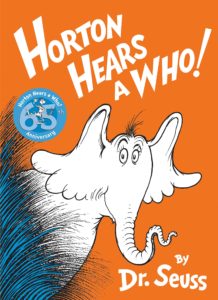
|
The most lovable, loyal, and admirable elephant of all time may just possibly be Dr. Seuss’s Horton. In Horton Hears a Who (Random House, 1954), big-eared Horton hears a cry for help from a small speck of dust and then bravely defends the tiny creatures who live on it, declaring “a person’s a person, no matter how small.” In Horton Hatches the Egg (Random House, 1968), Mayzie, a lazy and irresponsible bird, leaves Horton with her egg – which he doggedly cares for despite the taunts of his friends, because “an elephant’s faithful, one hundred percent.” You couldn’t have a better role model. For ages 2-7. |
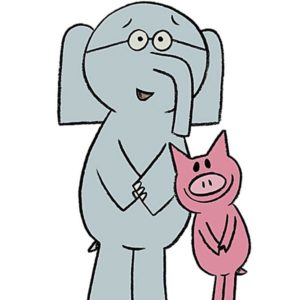
|
Mo Willems’s wonderful graphic-novel-style Elephant and Piggie series (Hyperion Books) star Gerald the Elephant, a down-to-earth practical type in spectacles, and his exuberantly optimistic friend Piggie. (“Today I will fly!” exalts Piggie. “No,” counters Gerald.). Titles include Today I Will Fly! (2007), We Are in a Book! (2010), and Listen to My Trumpet! (2012). |
| The World of Elephant and Piggie is a teaching guide to accompany the books. | |
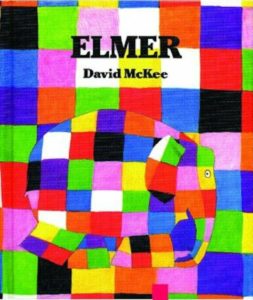
|
The title character of David McKee’s Elmer (HarperCollins, 1989) is funny, adorable, and – unlike all the other elephants – brilliantly patchwork-colored. Still, he wants to be gray, just like everyone else – though when he has a try at it, he discovers the error of his ways. A delightful book about the importance of being who you really are for ages 4-7. |
| Make a colorful Elmer-inspired elephant garland with this printable template. |
|
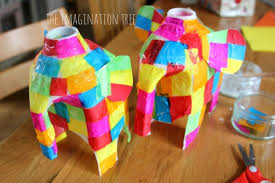 |
Make these great Elmer elephants with milk jugs and squares of tissue paper. |
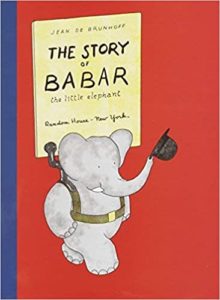
|
Jean de Brunhoff’s Babar first appeared in 1931, and today – along with family, friends, acquaintances, and enemies – appears in a long series of elephantine picture books for ages 4-8. In the first of these, The Story of Babar (Random House, 1937), young Babar loses his mother to a hunter, travels to the city, is adopted by a kindly old lady who outfits him in a green suit and sends him to school, and eventually returns to the jungle to become King of the Elephants. |
| For an interesting discussion of Babar’s pros and cons, see Adam Gopnik’s 2008 New Yorker piece Freeing the Elephants. | |
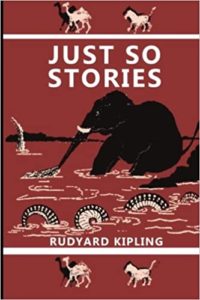
|
Remember the curious little elephant who met a crocodile on the banks of the great grey-green, greasy Limpopo River? The classic tale of how the elephant got his trunk is “The Elephant’s Child” in Rudyard Kipling’s Just-So Stories, originally published in 1902. There are many editions of the book – just avoid anything either Disney or abridged. The complete original text and illustrations can be found online. |
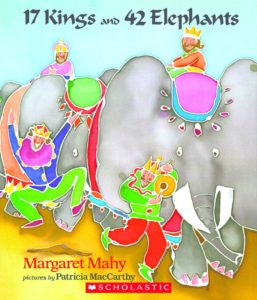
|
Margaret Mahy’s 17 Kings and 42 Elephants (Dial, 1987) is a rhyming journey through the jungle, filled with rollicking wordplay and crammed with crocodiles, hippopotamuses, flamingos, peacocks, tigers, and – of course – elephants. For ages 4-8. |
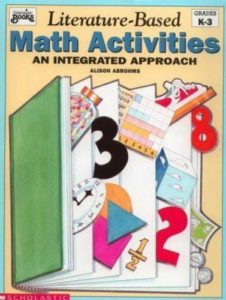
|
17 Kings and 42 Elephants is frequently used as a springboard to math – though many lesson plans simply reduce the book to unappealing word problems, as in “How many more pelicans than tigers were there?” Literature-Based Math Activities by Alison Abrohms (Scholastic, 1994), however – lessons based on 40 different picture books for grades K-3 – has a more interesting approach, suggesting that kids dramatize the book, make graphs based on the book, act as television reporters and “broadcast” numerical observations made during their jungle journey, and write a sequel to the book, describing the procession’s destination and what happens when they arrive. Abrohms’s book is out of print, but is available from online used-book suppliers and appears online as a Google book. Worth tracking down. |
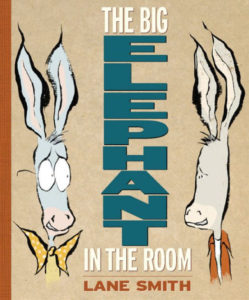
|
The expression “the elephant in the room” traditionally refers to an obvious looming truth that everybody ignores. Lane Smith’s The Big Elephant in the Room (Hyperion Books, 2009) is a picture-book twist on just that for ages 5-9. “Can we talk about the big elephant in the room?” one donkey asks the other – which sends the friend off into a hilarious guilt-ridden litany of admissions of wrong-doing. (“Is it that I made fun of your Rainbow Pony backpack?”) The joke, of course, is that there really is a big elephant in the room. |
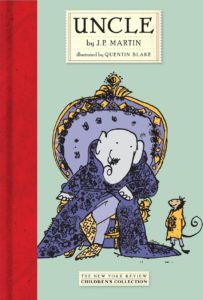
|
The star of J.P. Martin’s Uncle (New York Review of Books Children’s Collection, 2007) is a millionaire elephant who wears a purple dressing gown, has a B.A., lives in a ramshackle castle called Homeward (“think of a hundred skyscrapers all joined together”), and presides over a kingdom filled with weird and wonderful characters. Also see the sequel, Uncle Cleans Up. For ages 8-12. |
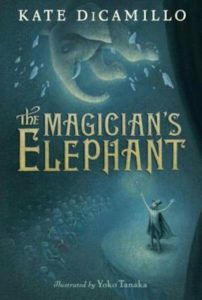
|
In Kate DeCamillo’s The Magician’s Elephant (Candlewick, 2009), ten-year-old orphan Peter Augustus Duchene learns from a fortuneteller that the sister he thought was dead is still alive – and that an elephant will lead him to her. That night a magician disastrously conjures up an elephant, who crashes through the roof of the town opera house. A dark, complex, and miraculous tale for ages 8-13. |
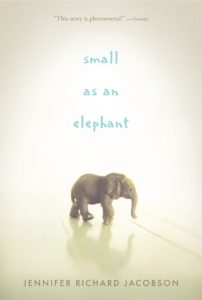
|
In Jennifer Richard Jacobson’s Small as an Elephant (Candlewick Press, 2011), Jack’s unstable mother has abandoned him at a campground in Maine and left for the Bahamas with a boat owner she met in a bar. Jack, fearful of intervention by social workers, tells no one about his predicament and sets out to find his own way home to Boston – despite having no money, food, or means of transport. On the way – with the (sometimes inadvertent) help of others – he begins to understand his mother’s problems, to come to terms with their relationship, and ultimately to re-connect with his grandmother. The book is a beautifully done view of reality and mental illness as seen through a boy’s eyes – and the connecting thread here is elephants. Jack is passionate about elephants, and each chapter begins with an elephant fact, story, or quotation. Despite some agonized soul-searching, Jack steals a small plastic elephant that becomes his support and consolation throughout his journey; and his own story as it unfolds echoes the behaviors of elephant families and herds. A wonderful read for ages 9 and up. |
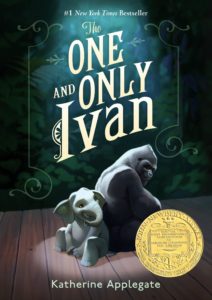
|
Katherine Applegate’s The One and Only Ivan (HarperCollins, 2012) is narrated by Ivan, a gorilla who lives in a glass enclosure in the Exit 8 Big Top Mall and Video Arcade, along with an elderly elephant, Stella, and Bob, a stray dog with a pithy vocabulary. All are befriended by George, the caretaker, and Julia, George’s little daughter, who first introduces Ivan to art, by sliding paper and crayons through a hole in Ivan’s glass wall. Then Mack, owner of the mall, buys Ruby, a baby elephant, in an effort to beef up his business. Stella loves Ruby and – before she dies – begs Ivan to find a way to free her. Through his art – and with a little interpretive help from George and Julia – Ivan does, and at the end both he and Ruby have found new homes and families at a good zoo (“where humans make amends”). This is a marvelous book, filled with intense, funny, and sometimes painful observations on freedom, captivity, and art, all in Ivan’s distinctive voice. Ivan acts like a gorilla – he eats his crayons, pounds his chest, and throws dung balls – but he’s a very human gorilla. Which statement he wouldn’t take as a compliment. For ages 8 and up. |
